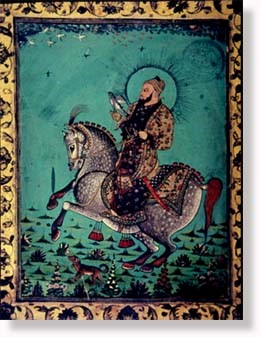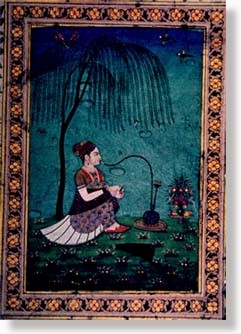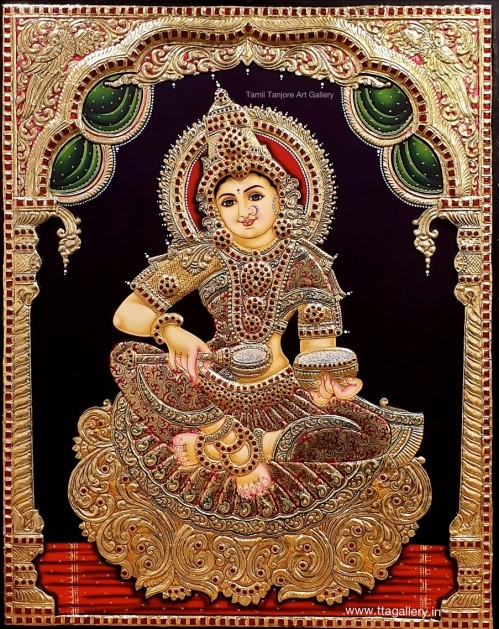Indian-heritage-culture / Indian Paintings / Decanni School of Painting
Decanni School of Painting
Early centres of painting in the Deccan, during the 16th and 17th centuries were Ahmednagar, Bijapur and Golconda. In the Deccan, painting continued to develop independently of the Mughal style in the beginning. However, later in the 17th and 18th centuries it was increasingly influenced by the Mughal style.
Some of the features of this school of painting are:
- Its unique sensuality and intense colours have a strong affinity to regional aesthetics.
- The school preferred dense composition and attempted to create an aura of romance, which invariably expressed itself in an idiom that was eloquently natural and vivid.
- A style of painting characterised by bold drawing, techniques of shading and the use of pure and brilliant colours flourished at Tanjore in South India during the late 18th and 19th centuries.
- Gold colour has been lavishly used in painting.
- Deccani costumes were richly depicted in this school of art.
Sub-schools in the Deccani school of painting
Ahmednagar
- The earliest examples of the Ahmednagar painting are contained in a volume of poems written in praise of Hussain Nizam Shah I of Ahmednagar (1553-1565) and his queen.
- This manuscript known as the ‘Tarif-in-Hussain Shahiand assigned to a period 1565-69 is preserved in the Bharat ltihas Samshodaka Mandala, Poona.
- Some other fine examples of the Ahmednagar painting are the “Hindola Raga” of about 1590 A.D. and portraits of Burhan Nizam Shah II of Ahmednagar (1591-96 A.D.) and of Malik Amber of about 1605 A.D. existing in the National Museum, New Delhi and other museums.
Bijapur
- In Bijapur, painting was patronized by Ali Adil Shah I and his successor Ibrahim II.
- An encyclopaedia known as the Najum-al-ulum (Stars of Sciences), preserved in the Chester Beatty Library, Dublin, was illustrated in 1570 A.D. in the reign of Ali Adil Shah I. This manuscript contains 876 miniatures.
- The ladies appearing in the illustrations are tall and slender and are wearing the South Indian dress.
- The rich colour scheme, the palm trees, animals and men and women all belong, to the Deccani tradition. The profuse use of gold colour, some flowering plants and arabesques on the top of the throne are derived from the Persian tradition.

Prince of Bijapur, Deccani School of painting
Golconda
- The British Museum in London houses a group of five charming paintings, believed to be the earliest identified Golconda work, dating back to about 1590 A.D. during the reign of Muhammad Quli Quta Shah (1580-1611) of Golconda.
- These paintings portray dancing girls entertaining their company.
- Another noteworthy example of Golconda painting is the "Lady with the Myna bird" created around 1605 A.D.
- This style of painting incorporates influences from the pre-Mughal northern tradition, which flourished in Malwa, and the Vijayanagar murals of the southern tradition, as reflected in the portrayal of female figures and attire. There is also an evident influence of Persian painting in the depiction of the golden sky and landscape on the horizon. The use of rich and vibrant colors distinguishes it from northern painting.

A painting in the Golconda style
Hyderabad
- The origin of painting in Hyderabad dates back to the establishment of the Asafjhi dynasty by Mir Qamruddin Khan.
- The painting style is predominantly decorative in nature.
- The miniature from the third quarter of the 18th century exhibits typical characteristics of Hyderabad painting, including rich colors and the use of Deccani facial types and costumes.
Tanjore
- During the late 18th and 19th centuries, a distinct style of painting characterized by bold drawing, shading techniques, and the use of pure and brilliant colors thrived in Tanjore, South India.
- The dense composition, surface richness, and vibrant colors of Thanjavur Paintings distinguish them from other painting styles.
- These paintings also feature embellishments such as semi-precious stones, pearls, and glass pieces that add to their appeal, and their relief work gives them a three-dimensional effect. The origin of Tanjore Painting can be traced back to the 16th century.
- Indian Thanjavur Paintings were patronized by Maratha princes, Nayakas, Rajus communities of Tanjore and Trichi, and Naidus of Madurai from the 16th to the 18th century.
- The majority of these paintings depict Hindu Gods and Goddesses, along with saints, as their main subjects.
- The main figure in a Thanjavur Painting is always placed at the center of the painting. Because these paintings are primarily executed on solid wood planks, they are colloquially known as ‘Palagai Padam’ (palagai meaning wooden plank and padam meaning picture) in the local language.

An example of Tanjore School of painting


